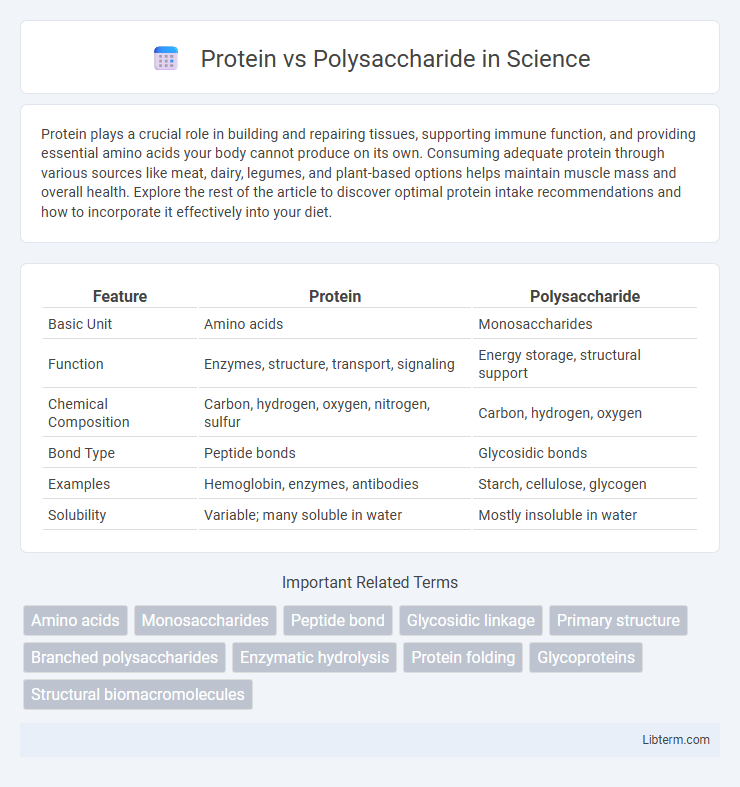Protein plays a crucial role in building and repairing tissues, supporting immune function, and providing essential amino acids your body cannot produce on its own. Consuming adequate protein through various sources like meat, dairy, legumes, and plant-based options helps maintain muscle mass and overall health. Explore the rest of the article to discover optimal protein intake recommendations and how to incorporate it effectively into your diet.
Table of Comparison
| Feature | Protein | Polysaccharide |
|---|---|---|
| Basic Unit | Amino acids | Monosaccharides |
| Function | Enzymes, structure, transport, signaling | Energy storage, structural support |
| Chemical Composition | Carbon, hydrogen, oxygen, nitrogen, sulfur | Carbon, hydrogen, oxygen |
| Bond Type | Peptide bonds | Glycosidic bonds |
| Examples | Hemoglobin, enzymes, antibodies | Starch, cellulose, glycogen |
| Solubility | Variable; many soluble in water | Mostly insoluble in water |
Introduction: Understanding Proteins and Polysaccharides
Proteins are complex macromolecules composed of amino acid chains that perform diverse biological functions including catalysis, structure, and signaling. Polysaccharides, large carbohydrates formed by long chains of monosaccharide units, primarily serve as energy storage and structural components in organisms. Both biomolecules are essential for cellular processes, with proteins facilitating biochemical reactions and polysaccharides providing support and energy reserves.
Structural Differences Between Proteins and Polysaccharides
Proteins are composed of amino acid chains linked by peptide bonds, forming complex three-dimensional structures such as alpha helices and beta sheets, which are essential for their diverse biological functions. Polysaccharides consist of long chains of monosaccharide units connected by glycosidic bonds, resulting in linear or branched structures that provide energy storage or structural support in cells. The primary structural difference lies in proteins' peptide bond-based polypeptides versus polysaccharides' sugar-based glycosidic linkages, influencing their distinct physical and functional properties.
Chemical Composition and Building Blocks
Proteins are composed of amino acids linked by peptide bonds, containing elements such as carbon, hydrogen, oxygen, nitrogen, and sometimes sulfur. Polysaccharides consist of long chains of monosaccharide units, primarily glucose, connected through glycosidic linkages, with carbon, hydrogen, and oxygen as their main elements. The differing chemical compositions and building blocks result in distinct structures and functions for proteins and polysaccharides.
Sources: Where Are Proteins and Polysaccharides Found?
Proteins are primarily found in animal products such as meat, fish, eggs, and dairy, as well as in plant sources like legumes, nuts, and seeds. Polysaccharides occur abundantly in plant-based foods, including grains, vegetables, fruits, and legumes, where starch and cellulose serve as common examples. Both macromolecules are essential for nutrition, with proteins providing amino acids and polysaccharides offering complex carbohydrates for energy.
Biological Functions in the Human Body
Proteins serve as essential building blocks for tissues, enzymes, and hormones, playing a pivotal role in muscle contraction, immune response, and cellular repair in the human body. Polysaccharides, such as glycogen and cellulose, primarily function as energy storage and structural components; glycogen stores glucose in the liver and muscles, supplying energy during increased metabolic demand. The distinct biological functions of proteins and polysaccharides highlight their complementary roles in maintaining metabolism, growth, and overall homeostasis.
Role in Nutrition and Health Benefits
Proteins serve as essential macronutrients responsible for tissue repair, enzyme production, and immune function, providing 4 calories per gram and containing vital amino acids. Polysaccharides, primarily complex carbohydrates like starch and fiber, supply sustained energy and promote digestive health by regulating blood sugar and supporting gut microbiota. Both play crucial roles in maintaining overall health, with proteins enhancing muscle synthesis and polysaccharides contributing to cardiovascular health through cholesterol management.
Digestion and Metabolism Comparison
Proteins undergo digestion primarily in the stomach and small intestine, where enzymes like pepsin and proteases break them down into amino acids for absorption and subsequent use in muscle synthesis and enzyme production. Polysaccharides are digested mainly in the small intestine by amylase enzymes, converting them into simple sugars like glucose, which enter the bloodstream and serve as a primary energy source. Metabolically, amino acids from proteins contribute to gluconeogenesis during fasting, while glucose from polysaccharides is rapidly oxidized through glycolysis and the citric acid cycle for immediate energy production.
Industrial and Medical Applications
Proteins serve vital roles in industrial applications such as enzymes in biocatalysis, improving reactions in pharmaceutical manufacturing and food processing, while their structural diversity enables targeted drug delivery systems in medicine. Polysaccharides, valued for their biocompatibility and biodegradability, are extensively used in wound dressings, drug encapsulation, and tissue engineering scaffolds, with industrial applications including biofilm formation and as thickeners in cosmetics. Both macromolecules' unique molecular properties drive innovation in biomedicine and sustainable industrial processes.
Dietary Considerations: How Much Do You Need?
Protein intake recommendations typically range from 46-56 grams per day for average adults, essential for muscle repair, enzyme function, and immune health. Polysaccharides, primarily dietary fibers, are advised in amounts of 25-38 grams daily to support digestion and regulate blood sugar. Balancing adequate protein with sufficient polysaccharide intake promotes overall metabolic function and long-term health maintenance.
Conclusion: Choosing Between Protein and Polysaccharide
Choosing between protein and polysaccharide depends on specific nutritional and functional needs; proteins provide essential amino acids critical for muscle repair and enzyme function, while polysaccharides primarily serve as energy sources and dietary fiber for digestive health. Athletes and individuals requiring tissue growth and immune support benefit more from protein intake, whereas those focusing on sustained energy release and gut health should prioritize polysaccharide consumption. Tailoring intake based on these biochemical roles ensures optimized physiological performance and overall well-being.
Protein Infographic

 libterm.com
libterm.com